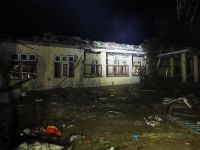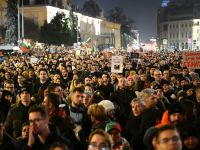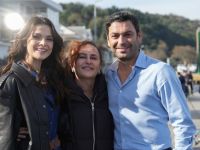Palms pressed together, a faceless figure elongates her arms as far as they can reach, above her head. A transparent cloth, printed with small squares, blankets her dark form. At the point where her fingers meet, a globule glows.
For photographer and visual artist Bushra al-Fusail, the image's creator, this is a midway point of sorts in the journey of self-discovery for Yemeni women, as explored in her series "Threads of Life." After evolving over the course of several previous slides, her subject has reached this way station.
"This one, I love," Fusail says breathlessly as she walks toward the picture during her recent exhibition at the Spanish Embassy in the Yemeni capital of Sanaa. "For me, it's like saying victory. Or you can say that she found her faith when she was completely lost…The lighting is behind her. I didn't use it in front of her because still, she's fighting."
The 26-year-old clothed her subjects in fabrics popular with Yemeni women to express what she calls their varied emotional spectrum. Fusail moves to the next shot: a voluminous stole encircles a woman's face, but this time, her forehead and eyebrows are prominent. Her eyes too emerge, though they are subtly obscured not by the material but by her shadow.
In the following frame, a light cloth pocked with golden circles tents over a woman's profile. Her head is swathed in gauze. "It's like she's recovering," Fusail says. "And I had this very strong light, because it's like finally, we're gonna get it…we're gonna get women's rights in Yemen."
Yet there are still some pictures to go, some stages to be endured. This is the crux of Fusail's work: It's not just art for art's sake. She has something to say.
"Every exhibition I do, it's like I have a message – it's not just artistic – I should have a theme, a strong message," she says.
Fusail keeps her artistic integrity intact to avoid being too didactic or obvious. Some of her heroes include Iranian photographers Shadi Ghadirian and Shirin Neshat whose work has shaken up stereotypes. In a similar vein, Fusail is among a cadre of Yemen's pathbreaking female photographers, including pioneer Boushra Almutawakel, who are providing fresh depictions of Yemeni women through their own lenses.
Their work pushes the bounds of quaint scenes showing narrow alleys busied by women in the colorful sitara, a traditional covering that Fusail says is overused in portrayals of the country.
Not For Art’s Sake
Fusail cruises around Sanaa in a worn white sedan. Hip-hop, rock, and pop songs pump from her iPhone into the car stereo. She keeps the windows rolled up. It's because of the men, she says. Part of a small but noticeable minority of women who chose not to wear the niqab, she wants to thwart the catcalls and “mashallahs” she's likely to fetch, though she's dressed in an abaya and headscarf. Even on a nice day or when the car gets stuffy, the windows stay shut. Instead, she blasts the AC.
Born in Yemen, Fusail lived until age 12 in Portland, Oregon. When her parents moved the family back to Yemen, she describes an isolation in those initial years. "It's like we couldn't accept people and they didn't accept us," she says of herself and her sister.
As she adjusted and matured, some aspects of Yemeni society started to gnaw at her. Things like not being allowed to travel alone and not being able to obtain a passport on her own. But it was also the lives of women in cities and villages, and even within her own family. An awareness around women's rights began to take root. Those experiences, both the extremely personal as well as the collective, are indivisible from her path as an artist.
But what exactly does she mean by "women's rights," in the first place?
"It does not mean it's like freedom or taking out the hijab or whatever," she says. "No, they're asking for something very simple: It's her education and her voice to say [what] she likes or dislikes. That's it. She's not asking for that much in Yemen, you know?"
After high school, Fusail got a job at a film production company headed by a German director. She helped out with the company's films, some centering on Yemeni women, while also attending university. Her parents weren't thrilled about her working, let alone going out on shoots.
Around this time, she also got her first camera, which she describes as "really crappy." Still, she worked as a freelance photographer, picking up some advertising gigs for big companies. To make it work, there's a lot she had to keep from her parents – sometimes making up stories or withholding certain details about where she was going – so she could sneak out for shoots.
For two years, she claims they didn't even know she was a photographer. But as a young woman with a bulky camera, word eventually got out.
"People, they called my mom, [and would say], 'Oh Aliya... we saw your daughter, she's not veiled and she's holding her camera,'" Fusail recounts in a mocking voice. "I used to fight with my mom a lot, because people they were calling [to say], 'We saw your daughter here, we saw your daughter there.' It's like I'm a whore going everywhere."
Her parents chided: "No, you're not going to be a photographer.” The daughter was determined as ever. She went on to have her first two exhibits. One was titled, "10 kg of Justice," spurred by what Fusail witnessed among relatives when it came to women being shortchanged in inheritance. That amount, 10 kilograms, is what she equated with how much justice exists for women in Yemen.
She attempted damage control, explaining to her parents what her photos were about. But after one of her show openings, "people came to my dad: 'Your daughter is doing this and this and this,' so people make them feel angry because I did it."
With some of her work symbolizing women's suffering, her parents worried that people might think they were torturing her. Although they didn't attend the exhibits, she convinced her family the topic was about women in villages and not about her. "But basically, it was us. It's us," she says, noting her intention was to represent all women.
Behind the camera, in spite of the struggles, something else was happening: her homeland transformed before her eyes. She spent more time in Sanaa's old city, a UNESCO World Heritage Site famed for its ancient high-rise homes made of rammed earth and lined with crescent-shaped, stain-glass windows. Her grandfather's house is located there and many of her relatives are residents. The same paths she used to walk along with her mother suddenly revealed their visual splendor.
"I guess I loved Yemen after I started to fight with my parents. It's like I explore more places. I explore the real beauty of Yemen," and not just close-mindedness, she says. "When I started to go out alone, without any 'bodyguards,' then I started…to love Yemen, I started to discover it, with my camera."
Through her pictures, Fusail tried to abstractly convey to her folks what women went through without having to engage them head-on. It's part of what draws her to photographic expression to begin with. "Instead of explaining and saying a lot and getting through a lot, I'm just gonna put it in one picture."
For their part, Fusail says her parents have come around. "From 2011, they are completely different. That's it – they gave up [the] fight," she says. Her modest studio is situated, after all, in their home. In addition, she says she's become stronger in standing up for her art.
Creative Horizons
Fusail is essentially self-taught, though she'd welcome formal training and exposure to artistic resources in some place like Italy. She's already blessed with that advantageous quality for an emerging talent: an entrepreneurial spirit. On her own, she approached Sanaa's German House, inquiring about their programs. After officials surveyed her work, she netted her first exhibition. Her pieces have since traveled to Europe for showings.
Since Yemen's revolution, Fusail says there is more interest in photography, especially photojournalism. For visual artists, however, there are still few resources and opportunities to hone their art via private sector and government venues, not to mention the little respect ascribed to their pursuits. To subsidize her passion, she works at an NGO.
Like others here, she says artists depend on foreign outlets such as the diplomatic cultural centers to share their creations. But there is a glint of hope. In her latest offering at the Spanish Embassy, which ran in November and December, a wealthy Yemeni businessman helped sponsor the event. Fusail says she was proud of this rare move, indicating the potential interest from fellow Yemenis to patronize the arts.
To those considering the field, Fusail advises: "You have to have the guts to do it. You have to explain to everybody why on earth instead of being a doctor, you're going to be a photographer. This is always their question." She also says to keep one's camera close, like she does, around her neck. "It's like your heart or your soul."
There are prospects for upcoming exhibits and invitations from abroad. Old obstacles, however, are never far. There's the tricky game of getting permission from her family to travel overseas and what ends of propriety she might be offending lately. What others think can still play a role, and the pressures of being an unmarried Sanaani girl are intense.
In fact, when Fusail talks about her future work, the theme of women dominates. One has to wonder though, doesn't it get old? Doesn't sticking to one subject dull creativity? And aren't depictions of alleged oppression overdone, especially coming from the Arab world?
"Some people they tell me, 'change your themes,'" Fusail says. "They're telling me, 'people are going to get bored of you.'"
But they won't tire, she says, because she'll have new ideas and present her subject matter in innovative ways.
"I'm not gonna change it unless women in Yemen stop suffering for gathering their rights," she says. "I know it's hard to change a traditional society. It's very crazy… At the beginning, when I did it, I was so scared. And then I was like OK, what the hell, I'm gonna be proud of it. I'm not gonna give up for this, unless I'm gonna see a majority of women having their rights."
Back at the Spanish Embassy exhibit, she points out the final piece in "Threads of Life." A Yemeni woman is adorned in a bold mesh textile. She glances at the camera, with the hint of a smile on her face. The woman has achieved what she sought. "It's not like she's very happy – but she's happy," Fusail says.
By: Nafeesa Syeed








